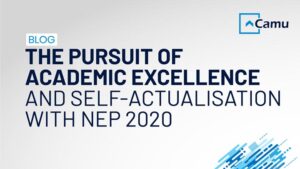
Breaking Through the Mind Block of Student Choice Based Enrollment
Blog by
AR Swami
21st-century students know what they want and there’s no stopping them.
Rightfully so, as the educational landscape is poised to grant students autonomy and freedom like never before!
But what does having a student voice actually look like?
Well, it looks a little bit like inclusion, integration, transformation and empowerment. This means, aspects like what to learn, how to learn, when to learn, where to learn, and from whom to learn, is decided by the student.
Across the globe, institutions have been exercising the Student Choice Based Enrollment system. However, in India, the process has not been adopted largely for two reasons;
- For a student in Higher Ed, the choices that govern the academic journey are very limited.
- Once a student joins an institute, he/she attends classes continuously until the last semester of study.
In this blog, Camu breaks through the mind block of a Student Choice Based Enrollment system. Read on to know how you, as an institute, can embrace this change successfully.
Overcoming myths with facts
The mind block associated with implementing a Student Choice Based Enrollment system can be attributed to certain myths that have been cultivated over a period of time.
The first one, is the notion that students are not mature or savvy enough to make their own choices and hence require definitive structure and guidelines. The second one, is that the choice-based model will require the support of more faculty members and additional classroom infrastructure. The third one, is that there isn’t an IT system in the market that will be able to manage and govern such dynamic operations.
However, research indicates otherwise.
Students, when given the opportunity to do so, are more likely to adopt a positive, cultural change. This is owing to the fact that new-age learners are comfortable enough to make decisions regarding their academic journeys. Secondly, the choice-based model will significantly reduce the demand and burden on teaching faculty and classroom infrastructure, as resources are optimised. Thirdly, IT systems such as Camu are compatible with all types of pedagogical approaches, making it easy for institutions to preside over.
Decoding the landscape
The National Education Policy 2020 promotes the use of a Student Choice Based Enrollment system, which is expected to gain recognition by accreditation bodies, and possibly be mandated in the near future.
Furthermore, the Ministry of Education recently announced the Academic Bank of Credit, designed as a digital bank that can hold the credits earned by a student in any course. A major instrument for facilitating multidisciplinary and holistic education, it paves the way for seamless student mobility.
With multiple entry and exit points, students can easily switch between or within higher educational institutes through a formal system of credit recognition, credit accumulation, credit transfers, and credit redemption.
Introducing the formula for success
A Student Choice Based Enrollment System is governed by the following criteria.
• The academic year is divided into an odd and an even semester.
• The curriculum structure is the flow chart for each student and they will traverse it as per the regulations.
• There is no class timetable; each student has a personal study plan.
• Lecture schedules are created before the end of the previous semester.
• Students may choose their courses and teaching faculty.
• Students are in different classes for each period, based upon their course registration.
• Students can complete their courses in fewer or more semesters, depending on their study plan.
• Students can transfer in and out of the institution at any point and carry their credits.
• Students are responsible for the meeting of graduation criteria
Building the roadmap for change
Institutions must keep the following aspects in mind when guiding the change towards a Student Choice Based Enrollment System.
- The existing curriculum design can remain as is, but will require understanding and awareness from faculty and students.
- Lecture scheduling for a semester must be done beforehand.
- Based on the lecture schedule, students will need to register for the courses and also select teaching faculty where possible.
- Students will have to register for the new courses and the arrears.
- An IT system must be put in place to allow for course registrations.
Listing the benefits of an IT system
Did you know, IT systems have been available since the early1990s, with intuitions offering a choice-based model for student autonomy and empowerment?
The impact of this superior EdTech solution is as follows.
- Allows course registrations based on the published lecture schedule.
- Enables students to register for courses as per the following rules:
a. available in their curriculum
b. not qualified previously
c. without conflict in timing
d. as per the credits to be earned in each category
e. as per the pre-requisites, co-requisites, and anti-requisites - Implements a CoE module, wherein exam registrations can be skipped. The course registrations will form the base for pre-exam activities.
- Facilitates quick results, so that course registration for the next semester can start immediately.
Camu has a brilliant track record (both locally and internationally), having successfully implemented a Student Choice Based Enrollment system in several institutions across India.







